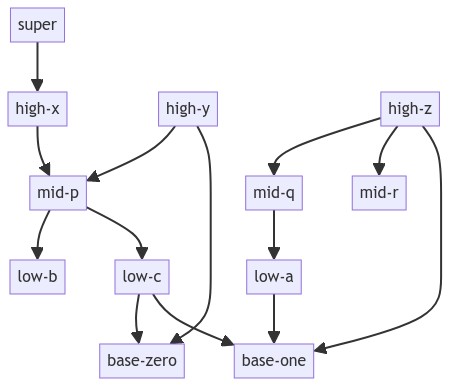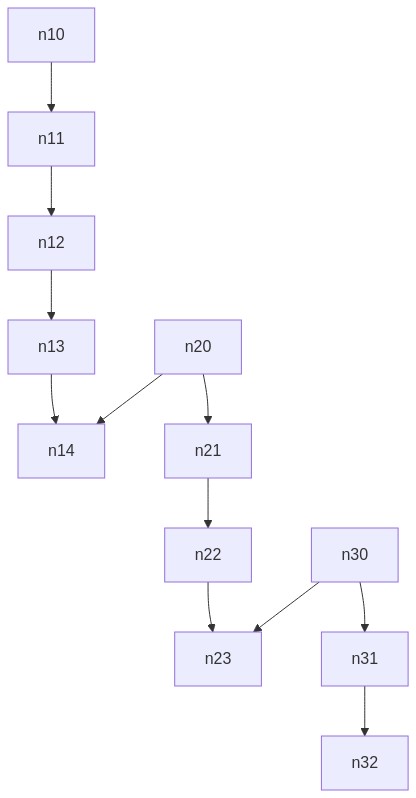How to calculate overall distances from lowest root(s) of a directed graph with networkx
If you look at this DAG (directed acyclic graph):
I want to create a dict which maps the distance from the lowest node(s) to all others nodes which is similar to the x position (height) of each node from the bottom in the rendered graph. For that given graph it would be:
distance_nodes_map: {
0: {'base-zero', 'base-one'},
1: {'low-b', 'low-a', 'low-c'},
3: {'high-x', 'high-z', 'high-y'},
2: {'mid-r', 'mid-q', 'mid-p'},
4: {'super'}
}
I wrote an algorithm which worked for that graph above but then I've tested another graph and it didn't work anymore. I tried some algorithms and functions like shortest path or descendants_at_distance but I don't think they are really helpful as an input to calculate the distances.
My algorithm doesn't work for instance for this graph:
https://gist.github.com/timaschew/3b08a07243fa6f43773014ef5e705c96
Here is gist which contains:
- a python script which reads a YAML file, the dependency/graph structure and generates a HTML with a rendered mermaid graph (I've removed my algorithm to calculate the distances in a wrong way)
- both graphs which are shown here, as a YAML file
You are looking for an algorithm that draws a layered graph. There are many different algorithms, and you should choose the one that best fit your needs (for example, have a look at the following paper A Technique for Drawing Directed Graphs by Gansner et al.).
Many of those algorithms are already implemented in Graphviz (a very famous and powerful graph visualization software). Once you have installed it, it's pretty straightforward to compute the result you are looking for (G is your directed acyclic graph built using networkx.DiGraph):
from networkx.drawing.nx_agraph import graphviz_layout
def get_distance_nodes_map(G):
pos = graphviz_layout(G, prog='dot')
coor = sorted({y for k, (x, y) in pos.items()})
kmap = dict(zip(coor, range(len(coor))))
distance_nodes_map = {level: set() for level in kmap.values()}
for k, (x, y) in pos.items():
distance_nodes_map[kmap[y]].add(k)
return distance_nodes_map
Here are a couple of examples using data that you provided:
>>> from networkx import DiGraph
>>> from pprint import PrettyPrinter
>>> pp = PrettyPrinter()
>>> G1 = DiGraph()
>>> G1.add_edges_from([('super', 'high-x'), ('high-x', 'mid-p'),
... ('mid-p', 'low-b'), ('mid-p', 'low-c'),
... ('low-c', 'base-zero'), ('low-c', 'base-one'),
... ('high-y', 'mid-p'), ('high-y', 'base-zero'),
... ('high-z', 'base-one'), ('high-z', 'mid-r'),
... ('high-z', 'mid-q'), ('mid-q', 'low-a'),
... ('low-a', 'base-one')])
>>> pp.pprint(get_distance_nodes_map(G1))
{0: {'base-one', 'base-zero'},
1: {'low-a', 'low-b', 'low-c'},
2: {'mid-p', 'mid-r', 'mid-q'},
3: {'high-y', 'high-x', 'high-z'},
4: {'super'}}
>>> G2 = DiGraph()
>>> G2.add_edges_from([('n10', 'n11'), ('n11', 'n12'), ('n12', 'n13'),
... ('n13', 'n14'), ('n20', 'n14'), ('n20', 'n21'),
... ('n21', 'n22'), ('n22', 'n23'), ('n30', 'n23'),
... ('n30', 'n31'), ('n31', 'n32')])
>>> pp.pprint(get_distance_nodes_map(G2))
{0: {'n32'},
1: {'n31', 'n23'},
2: {'n30', 'n22'},
3: {'n21', 'n14'},
4: {'n13', 'n20'},
5: {'n12'},
6: {'n11'},
7: {'n10'}}
- Python method chaining in functional programming style
- flask-jwt-extended: Fake Authorization Header during testing (pytest)
- For loop through the list unless empty?
- Polars make all groups the same size
- Is there a way to specify a default base-template for all templates in django?
- How to tackle time limit exceeded error in leetcode
- Is pd.get_dummies() updated in newer versions of Pandas making it default to Booleans (True/False) instead of (0/1)?
- What's the function like sum() but for multiplication? product()?
- How to type hint a dynamically-created dataclass
- Issue with pulling the data with EIA API with Python
- 403 Forbidden Error when scraping a site, user-agents already used and updated. Any ideas?
- Fullstack web-hosting services
- How to handle an AnalysisException on Spark SQL?
- Python requests is slow and takes very long to complete HTTP or HTTPS request
- Is there a way to modify an element in a Numpy array based on the value of other elements?
- Tkinter grid manager height/width nonconsistent
- Sql Alchemy Insert Statement failing to insert, but no error
- How can I create a Polars struct while eval-ing a list?
- Excel using win32com and python
- django: on pypy, psyco, unladen swallow or cpython, which one is the fastest?
- How convert a list into multiple columns and a dataframe?
- Name not defined in type annotation
- Static type checkers and Language Servers not recognizing attributes of objects that are subclasses
- How do I get multiple OID values in PySNMP?
- how to log a file in Django
- Is there a simple and efficient way to evaluate Elementary Symmetric Polynomials in Python?
- Iterating over two lists one after another
- Python -i flag for production
- What is PyCompilerFlags in Python C API?
- How to make Python check whether a variable is a number or letter

